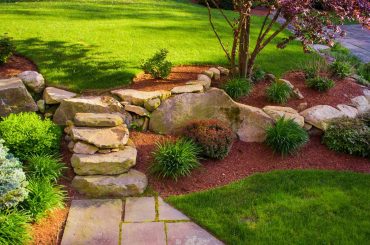Table of Contents
Gardening isn’t just about growing plants; it’s also about keeping the walls of your home looking good.
Dirt doesn’t just make a mess; it can also leave marks on your walls, whether they’re covered in vinyl or wood. Let me guide you through some easy ways to make sure your walls stay as neat as your flowers.
Proactive Garden Layout for Siding Preservation
Designing a garden that not only looks pretty but also acts as a guardian for your house’s siding. By keeping a proper distance between your plants and the siding, keep those walls dry and happy.
When planning your garden layout, consider eco-friendly siding options that will hold up well with proper moisture and sun protection.
Knowing the path of the sun throughout the day will help you position plants in a way that utilizes sunlight while also protecting vulnerable siding. Make note of areas that get intense afternoon sun or those that stay shaded.
Garden Layout
The golden rule? Keep plants at least a couple of feet away from the siding. This space allows air to flow and keeps the siding dry, discouraging mold and mildew. It’s like giving your house some breathing room after a heavy rainstorm.
Don’t let the required distance from the siding limit your creativity. With the right plant choices, you can create beautiful, lush gardens that still protect your home’s exterior. Use trellises, arbors, raised beds and container gardens to add vertical interest while steering plants away from siding.
Plant Placement
When placing plants, think like a chess player. You want to position them strategically. Tall plants that might trap moisture against the siding? Those go further back. Short, sun-loving flowers that don’t hold onto water? Those can be closer. It’s all about balance.
Be proactive in maintaining your thoughtfully designed gardens. Prune back plants that get unruly and keep climbers neatly trained. Address issues like mildew and moisture damage early before they can impact siding. With some foresight and care, your garden can be an asset, not a liability, for your home’s exterior.
Safe and Effective Siding Cleaning Methods
DIY Cleaning Solutions
Before you go on a shopping spree for cleaning products, let’s talk about the DIY concoctions that are both siding-friendly and easy on the wallet. A bit of dish soap, water, and some elbow grease can work wonders. Think of it as the home remedy for a dirty house – simple, effective, and readily available.
Effective Pressure Washing
Pressure washers can be your best friend or your worst enemy. It’s like having a superpower—use it wisely. Too much pressure and you might damage the siding; just the right touch and your siding comes out looking like new.
The key to pressure washing siding is finding the optimal pressure level. Too much can damage the siding, while too little won’t clean effectively. Test different settings to find the right balance for maximum cleaning with minimum risk.
When to Use Pressure Washers
Now, wielding a pressure washer can make you feel like a superhero, but with great power comes great responsibility. Use it on a low setting to avoid any damage, and keep it moving so it doesn’t focus on one spot too long. It’s like giving your siding a gentle massage instead of an intense workout.
Pressure washing can be an effective way to clean siding, but it’s important to use the right pressure and technique. Being too aggressive can actually damage the siding. A light touch is best for optimal cleaning without causing harm.
Oxygen Bleach Solution
Imagine a cleaner that’s tough on dirt but gentle on your house. That’s your oxygen bleach solution. It’s like that mild-mannered friend who turns out to be a superhero when trouble arises. Mix it up, apply it, and watch the stains give up the fight.
Oxygen bleach is a great eco-friendly cleaning solution for siding. It works to lift stains without using harsh chemicals that could degrade the siding over time. When mixed properly, it can make the siding look like new again.
Chlorine Bleach
Chlorine bleach, however, is like the friend who’s a little too intense. It means well, but it can be harsh. Best to save it for the tougher jobs, and even then, use it sparingly. Like that one friend, it’s not for every situation.
While chlorine bleach is an effective cleaner, it can damage siding if overused. Only use it for tough stains, dilute it properly, and rinse it off thoroughly to avoid degrading the siding over time. Moderation is key with this strong cleaner.
The Right Brush
Choosing the right brush for the job is like choosing the right tool for a painting. You want one that’s tough enough to scrub away dirt but won’t leave its own marks behind. Think of it as the brush you’d trust to clean a cherished painting—effective yet gentle.
When brushing siding by hand, select a soft bristle brush. Stiff brushes can actually scratch or scuff the siding. Look for a brush designed for delicate surfaces that can lift dirt without damaging the material underneath.
Regular Maintenance to Prevent Buildup
Consistency is key. Just like you wouldn’t wait until your car is buried in dirt to wash it, don’t wait until your siding is unrecognizable. A regular spritz with the garden hose can prevent dirt and algae from throwing a permanent party on your house.
Washing your siding once a month can go a long way in keeping it looking fresh and clean. Set a reminder on your calendar to help you remember. It only takes about 15-20 minutes with a hose to spray down all sides of your home. The small time investment pays off in keeping your siding beautiful.
Tackling Algae and Mildew
Speaking of uninvited guests, algae and mildew can be the ultimate party crashers. To send them packing, mix up that oxygen bleach solution we talked about, or for smaller areas, a vinegar and water mix can be surprisingly effective. It’s like telling those pests, “Sorry, you’re not on the guest list.”
If the algae and mildew still persist after initial cleaning attempts, don’t hesitate to bring out the big guns. You may need to use a pressure washer for concentrated cleaning power. Wear protective eyewear and clothes to stay safe during power washing. The results will be worth the effort.
The Weather Factor
Weather can be a friend or a foe. Clean your siding on an overcast day to prevent the sun from drying your cleaning solution too quickly. It’s like picking the right day for a picnic – timing is everything.
Cooler temperatures in the early morning or evening are ideal for siding cleaning. Avoid the hottest part of the day when the sun can quickly bake cleaning solutions onto the surface. Check the weather forecast to pick the coolest day if possible. Proper planning prevents poor cleaning results.
Final Touches for a Spotless Appearance
Once you’ve given your siding the spa treatment, it’s time for the finishing touches. Rinse off any remaining cleaner with your trusty garden hose. Consider it the final rinse after a refreshing facial – necessary for that fresh, clean feeling.
Make sure to rinse top to bottom, starting at the top of the wall and working your way down. This will prevent streaking from any cleaner residue running down the siding. Double check corners and crevices to ensure you didn’t miss any spots. Stand back and admire your sparkling clean siding when you’re done!
The Importance of Regular Inspections
Lastly, keep an eye on your siding like you would on a mischievous pet. Regular inspections can catch small issues before they become big problems. Look for cracks, warping, or any other signs of trouble. It’s better to be the proactive homeowner who spots a small leak than the one who discovers a flood.
Schedule seasonal inspections during spring and fall when temperature changes stress materials. Inspect after major storms as well. Look for anything out of the ordinary and address immediately. An ounce of prevention is worth a pound of cure when it comes to siding maintenance.
Conclusion:
In conclusion, you can keep your siding clean while gardening through strategic plant placement, using gentle cleaners, washing regularly, and inspecting seasonally.
Position plants away from walls so air can circulate. Clean with care using soft brushes and mild solutions like oxygen bleach. Wash monthly to prevent buildup. Inspect siding in spring, fall, and after storms.
With this thoughtful approach, your siding will stay pristine as your garden thrives. A little diligence goes a long way in maintaining clean walls while enjoying your outdoor paradise.





